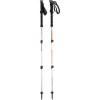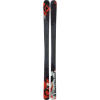Indeed, the winter is nearly upon us. I know this not only because the calendar says so, but because Tramdock has been running more and more great deals on last year’s junk, because the beer store only has Christmas flavored beer (actually that’s a terrible weather vane, but I digress), because Ski-Net started up the where-to-ski-this-weekend column, because Skiing put out the ever dubious Top 100 Reports report , because I can see my breath nearly every morning (thank God, I can finally breath again), and because most importantly my enthusiasm for skiing has crept back into the spectrum of unbridled mania.
 |
Powder baskets – lets hope they
see some abuse in the upcoming weeks! |
As a direct result of this uncontrollable enthusiasm a number of seasonal prerequisite tasks have come into sharp focus: deal hunting for a new, non-battered helmet seems advisable, perhaps a new winter day-pack, a few new sets of ski socks, etc, etc… But most important of all: the arsenal of skis must be ready to handle any imaginable set of conditions (and maybe even some unimaginable conditions). A year or so ago, after I realized that my K2 Shuksan AT skis fell apart (under the rigors of being owned by me), I impulsively bought a pair of Head Monster 95s – an ultralight backcountry touring ski with a real propensity for powder. When they showed up at my apartment I instantly realized that they had no application in this part of the world, put them in the corner and got a pair of more well mannered Black Diamond Havocs – something I could probably work with inbounds, in the woods, the side country and the New England backcountry. I had my Marker Dukes bolted on and was ready to go.
However this year, I’ve set my sights a bit higher. With strong ambitions of doing not only as much backcountry skiing as possible but as much powder skiing as possible, I decided it was time to round out the quiver by mounting the Monsters. The advent of Quiver Killers has eliminated the need to more than one pair of touring binding, which previously was the major barrier to entry for building a truly well rounded quiver of skis.
 |
| Heel piece pulled off revealing the inserts. (Click these to zoom.) |
For those who are still in the dark about this revolutionary (and remarkably simple) new technology, here’s the run down. The general rule of thumb regarding mounting skis is that you can only drill into a given pair 3 times before all the holes in the ski have begun to compromise it’s structural integrity. They’ll be weakened, won’t flex correctly, and won’t hold a binding as well. This essentially meant that each pair of skis needed its own dedicated pair of bindings – hot swapping was out of the question. Now, with quiver killers installed, you can readily move one pair of bindings between skis. The Quiver Killer Insert is a small metal fitting that is sunk into the ski and has machined threads inside it’s hollow center. It allows you to easily, quickly and without causing any damage to the ski, screw, unscrew and re-screw to your hearts content a set of bindings and place them on any other pair of skis with inserts. The process if moderately involved and costs a few bucks, but saving nearly 400 bucks is worth the afternoon that it takes if you plan to ski lots of varied terrain. Below is a discussion of the installation process.
 |
Eye candy just to get you fired
up about the long, dry read ahead. |
For starters, there are essentially two scenarios to consider going into the installation. The first, and easiest situation is that you have a pair of skis with bindings already mounted which you’d like to refit with Quiver Killers. This is easy because you don’t have measure all of the spots that need to be drilled. You just bore out the original holes, and set the inserts into them (more detail to follow). The second and semi-complicated situation is that you have a brand new pair of skis which have never had bindings or you have a pair of skis that had some different pair of bindings – in either case you need to carefully get the drill points measured out and marked otherwise your bindings wont screw onto your skis.
The first pair I tried to install were my Head Monsters which I completely botched. Dismayed, I turned to the BD Havocs which were pre-drilled from when I had REI mount my Dukes on them. This worked out much better, and with new found confidence, I patched up the Monsters and took a second stab at them this past weekend.
The first order of business is to pull the Dukes off of the Havocs. This is done with a number 2 Phillips screw driver. Next, you’ll want to set up a template to aid you in the drilling process. If you have the original that came from the factory use it!!! The Quiver Killer website provides a few common templates, however since it will be longer than 11″ it comes on two sheets of paper. You must be meticulous in splicing these two sheets together. This also means that you must be sure your printer scaling is correct. It seems that mine may not have been. Alternatively, maybe the template on the Quiver Killer site was wrong. In any event double, triple, and quadruple check your template using something of known validity! I used my Havocs as a guide and penciled in a few micro adjustments.
 |
| Measure twice, cut once, says my wizened Dad. |
Next you’ll want to tape the template to the topsheet of the ski that you intend to drill. You should verify that the factory center line printed on your skis is indeed accurate, or at least in the same spot on each ski. Once you are satisfied with center (or 3cm aft in my case, since I was aiming to create a powder slaying beast), use a razor blade, or other pointy instrument to score the topsheet so that won’t loose your center. Next you should find the center of the template. This is slightly arbitrary since sole length and shell size aren’t really related – the main point is that you identify something pretty close to center and do the same thing on the other ski! By poking a hole in the template with a nail set (or other pointy implement) you can line up the template center with your ski center.
 |
Use something pointy to mark true center –
pencil and ink will smudge on a smooth topsheet. |
Now that the two ‘centers’ are lined up you need to be sure that you center the toe and heel areas of the template. An accurate way of doing this is by finding the center of the ski at some point fore or aft of the template. Mark this point. Now, place a ruler on top of the template flush with the nail set and the center mark you just found fore or aft of the template. Pivot the template around the nail set until the template center line falls directly under the ruler. Whilst holding your breath (and ideally, causing your hear to temporarily stop beating) tape the the whole thing to the ski. Using a sharp nail set, create little depressions in the topsheet at each of the drill points. This allows you to reuse the template and is better than ink or pencil which will smudge as you work. You can now remove the template from the ski and set up your drill press.
 |
| Center lines and mount points marked using a razor and nail set. |
This is probably the most complicated part of the entire operation simply because it seemed like a no brainer – it was anything but. This may be specific to the skis I was working with, however the topsheet of the head monster is so resilient and resinous that the drill bit, even while attached to a press, would walk a bit before it totally penetrated. All of the drill points would be slightly askew (in the same direction, albeit not where I wanted them to wind up). I found that the solution was to cut away the topsheet around the drill points using an exacto knife with a semi-circular blade. Basically you scoop out a little divot so that the bit can’t walk away from the target before it starts to bite into the core material. I have no idea how they deal with this in ski shops, but I’d love to know because this was by far the most labor intensive part of the whole project.
 |
All is not lost, they can be fixed to some degree. This, of course, was after
Dad explained to me the principle of ‘measure twice, cut once’ but
before he reminded me of it… |
Now seems to be a good time to mention the disaster recover strategy. If, like me, you mangled your skis on your first attempt, you can fix them. My solution was to fill the bad drill points with a quarter inch dowel and Gorilla Glue. If any of the dowels should pop out, you can stuff a bunch of steel wool into them to take up the space and create a bunch of surface area to aid in bonding.
After this is accomplished you can bore out the drill points using a quarter inch bit and a stop collar set just a tad deeper than the height of an insert. Remember you want the insert to be flush with the ski or a tad depressed, and you’ll be sticking a big glob of epoxy into the whole before you finish.
 |
| 1/4″ bit, stop collar, and some fortunate Exacto blade. |
Once you’ve bored out all of the holes you need to tap them so that the outer threads of the inserts have something to hang onto. This is done with a 5/16″ bottom tap. Be sure not to crank down too hard or you’ll start to poke into the P-Tex.
 |
| Bottom tap and tap handle. Try to aim straight down! |
 |
| Setting an insert. |
 |
| Finished insert. |
 |
| Victory! |
Once all of the holes are tapped you can begin to set the inserts. Be sure that the inserts are free of any machining oils by bathing them in rubbing alcohol. Next shoot a dollop of 24 hour epoxy into the hole. The main point of the epoxy, beyond fastening the insert is to waterproof the core of the ski. The Quiver Killers come with a special ‘installation tool.’ The installation tool consists of an inch long M5 bold with two hex nuts on the bottom. Twist an insert onto the bottom of the M5 bold and lower the two hex nuts so that all three pieces are in contact. The friction will cause the entire assembly to be a static unit. You can then use a number 2 Phillips head screw driver to set the Quiver Killer into the hole. The bottom hex nut will act as a guide stopping the insert once it’s in place. Using an opened ended hex wrench, back the two nuts away from the insert, relieving the friction. You can then back the M5 bolt out of the insert without taking the insert with you. Using a paper towel with some rubbing alcohol (or similar) wipe away any excess epoxy. Do this like a million or so more times and BAM, you’re done! Go ahead and plop your bindings over your new inserts and crank the M5 screws into your skis.
Gear List (click links for more product info):







